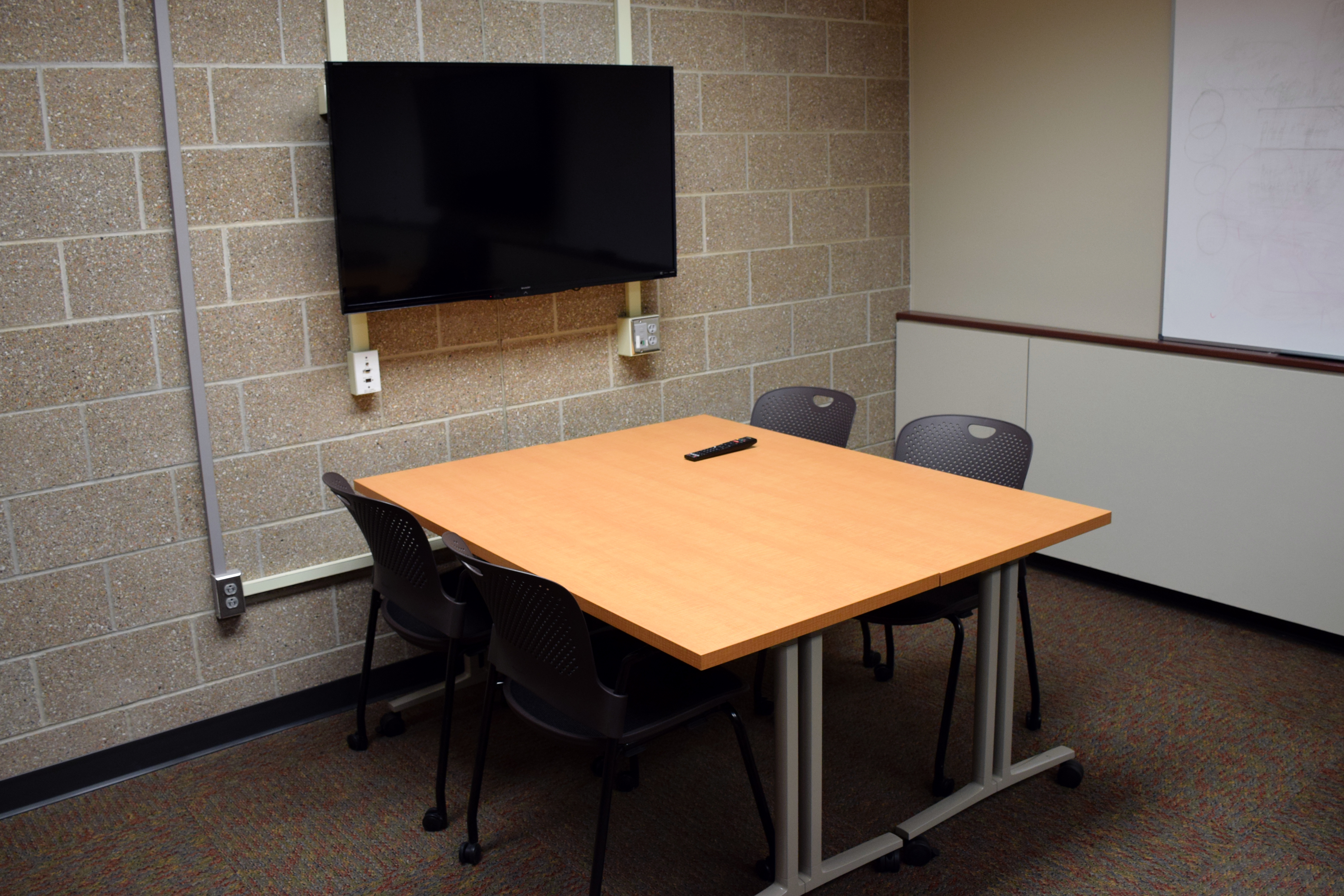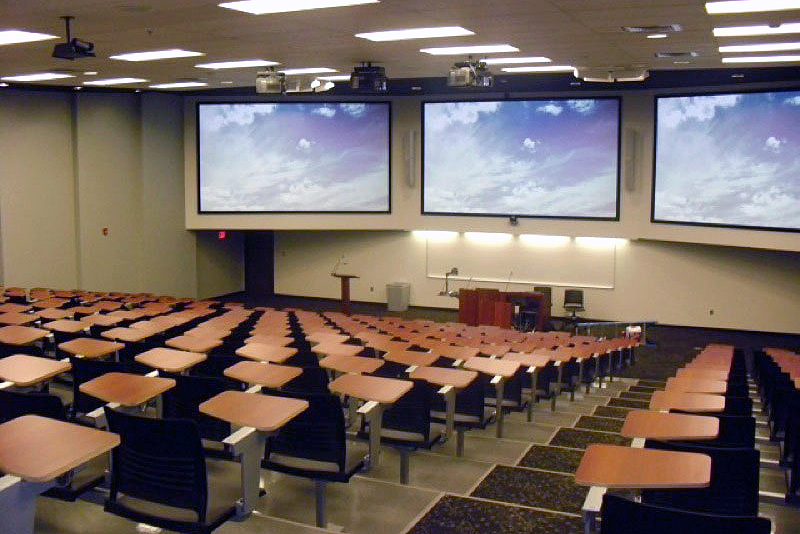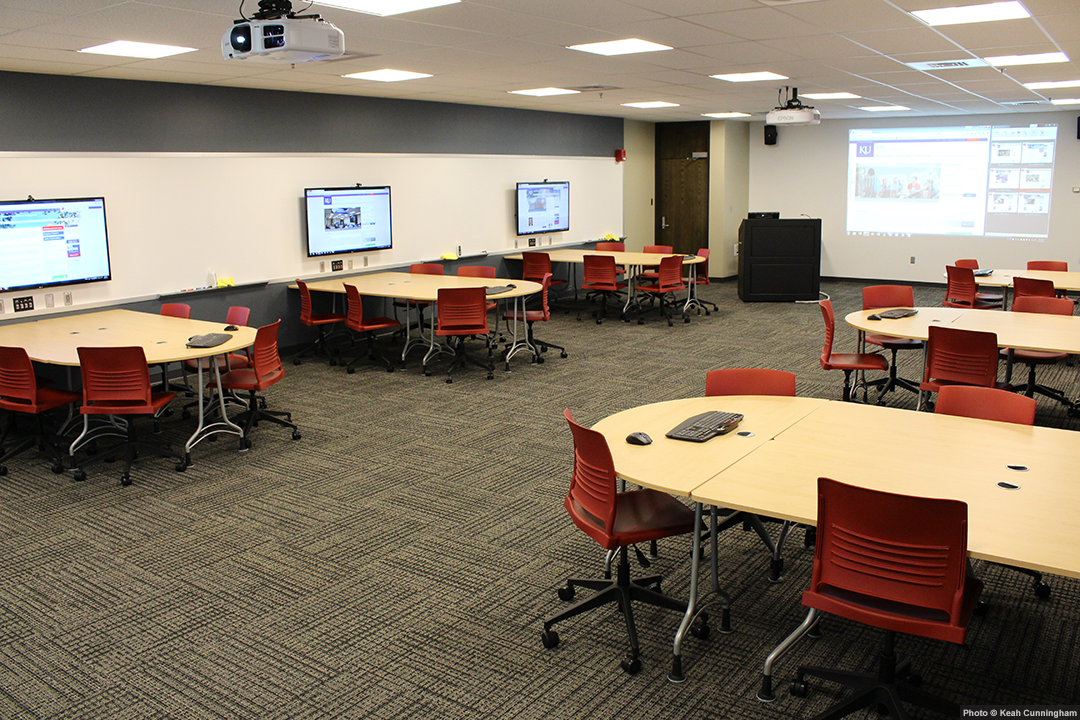Room Types & Technology Standards
For a comprehensive list of rooms by type, see Room Directories by Type. *All installations are unique. A site visit and consultation is required to provide exact estimates. For a detailed explanation of each room type, including standard technology features, please select from the following:
Basic Presentation Office/Conference Room

Standard Technology Features for Basic Presentation Office/Conference Rooms:
Projector, wall or cart mounted - WXGA or WUXGA resolution projector with an output of 3,500 to 5,200 ANSI lumens (Brightness and Color Light output), ceiling mounted Projection screen (size dependent on room configuration)
- Pull-down or motorized projection screen
- The bottom of the projected image will not be lower than 48” from floor.
- Screen height will be 1/5 the distance from the front wall to last row of seats
- Flat panel display size dependent on room
- Single source presentation via direct cable connection, wall and or table mounted input panel via: VGA, HDMI, Audio
- Power
- USB
- Both a wired and wireless network connection shall be provided
- Wall plate or table mounted input panel for connectivity to display
- Control via wireless remote for display and input control
- Audio distribution via display (projector or flat panel) speakers
- Display can be used for digital signage. See KU Digital Signage for information
Media Classroom
 The media classroom A/V standards cover the majority of classrooms at KU. Most general classrooms are lecture/discussion rooms that seat up to 99 people. Media classrooms include lecture capture capabilities and a video display with multiple content sources centrally controlled and located from a media lectern/podium with options for expansions. *Starting cost: Around $25,000, not including installation, furniture and infrastructure.
The media classroom A/V standards cover the majority of classrooms at KU. Most general classrooms are lecture/discussion rooms that seat up to 99 people. Media classrooms include lecture capture capabilities and a video display with multiple content sources centrally controlled and located from a media lectern/podium with options for expansions. *Starting cost: Around $25,000, not including installation, furniture and infrastructure.
Standard Technology Features for Basic Presentation Office/Conference Rooms:
WXGA or WUXGA resolution projector with an output of 3,500 to 5,200 ANSI lumens (Brightness and Color Light output), ceiling mounted Projection screen (size dependent on room configuration)
- Pull-down or motorized projection screen
- The bottom of the projected image will not be lower than 48” from floor.
- Screen height will be 1/5 the distance from the front wall to last row of seats
- Flat panel display size dependent on room
- Desktop computer with wired network access
- Desktop computer is usually Windows OS (PC)
- Determined by needs of department and instructor after consultation with IT Classroom Technology
- Document Camera
- Media Players – Blu-ray, DVD
- Size and functionality of lectern will vary depending on type of learning space and multimedia required
- Top surface will include space for writing and a document camera
- Cables for laptop/device connection will route through lectern
- If multimedia equipment is rack-mounted in the lectern, lectern will be properly ventilated
- Locking access door on back of lectern for service access
- Installed power on or near lectern for external devices
- 4 installed and 2 active network connections on or near lectern
- Tethered for mobility
Sound amplification system. Wall and or Ceiling mounted speakers for distributed source audio.
- Extron control system for audio and display controls with single output to display. Wall or Lectern/Podium mounted control panel.
- Control system design and layout standard design as per IT recommendation and user requirements. (See KU Brand Identity for approved colors, logos, and other design elements)
- Remote monitoring available via Extron Global viewer
- Laptop connection to video and audio systems (VGA and HDMI)
- Power
- USB
- Both a wired and wireless network connection shall be provided
- Lecture Capture hardware and software installed
- Supplemental software may be installed on the desktop computer
- Additional inputs for added functionality
- Wireless AV Presentation Software
Writable surface either attached to the walls or mobile to facilitate student collaboration.
Auditorium

Auditorium provides displays with multiple content sources (Computer, laptop connection, document camera, DVD, and microphones for voice reinforcement) all located and controlled from a media lectern/podium. Full media auditoriums typically have lecture capture capabilities and tiered seating with a capacity greater then 90. *Starting Cost: Around $50,000, not including installation, furniture and infrastructure.
Standard Technology Features for Auditoriums:
The large venue A/V standard covers the majority of spaces at KU with 100+ students. Rooms with large venue A/V standards typically include multiple displays with multiple content sources all centrally located and controlled from a media lectern/podium with options for expansion.
- WXGA or WUXGA resolution Large venue projector with up to 10,000 ANSI lumens (White & Color Light output), ceiling mounted or installed in projection booth (if available) Possible multiple projected images (depending on physical layout of room)
- Single or Multiple display
- Projection screen (size dependent on room configuration)
- Motorized projection screen in most cases unless retro fit does not permit.
- Fixed Projection Screen
- Desktop computer with wired network access
- Desktop computer is usually Windows OS (PC)
- Determined by needs of department and instructor after consultation with IT Classroom Technology
- Document Camera
- Media Players – Blu-ray, DVD
- Size and functionality of lectern will vary depending on type of learning space and multimedia required
- Top surface will include space for writing and a document camera
- Cables for laptop/device connection will route through lectern
- If multimedia equipment is rack-mounted in the lectern, lectern will be properly ventilated
- Locking access door on back of lectern for service access
- Installed power on or near lectern for external devices
- 4 installed and 2 active network connections on or near lectern
- Tethered for mobility
Extron control system for audio and display controls for single or multiple displays
- Control system design and layout standard design as per IT recommendation and user requirements. See KU Visual Identity for approved colors, logos, and other design elements
- Remote monitoring available via Extron Global Viewer
- Matrix switching for multiple display
- Sound amplification system. Wall and or Ceiling mounted speakers for distributed source audio
- Microphone (podium based)
- Wireless microphone system
- Sound reinforcement system tied to Lecture Capture
- Assistive Listening System (FM or Induction loop)
- Laptop connection to video and audio systems (VGA and HDMI)
- Power
- USB
- Both a wired and wireless network connection shall be provided
- Display for annotation capabilities
- A Lecture Capture appliance or software solution based on hardware capabilities in the designed space.
- If soft codecs or other software AV solutions are needed, the system shall include an AV Bridge to support installed cameras and microphones.
- Visit Lecture Capture for more information
- HD cameras installed for lecture capture or video conferencing if installed.
- Additional inputs for added functionality. (User provided device, etc...)
- Wireless AV Presentation Software
Writable surface either attached to the walls or mobile to facilitate student collaboration.
Collaborative Space
 Active Learning rooms promote collaborative learning, in which students work together on mobile platforms, with the ability to connect at stations and share their work electronically or on a writable surface in the room. Faculty are able to control the video displays remotely with various wired or wireless technologies enabling them to move about the learning space freely. Extra resources may be necessary and may require additional planning depending on the layout and configuration of the space which is always evolving and changing. *Starting Cost: Around $50,000, not including installation, furniture and infrastructure.
Active Learning rooms promote collaborative learning, in which students work together on mobile platforms, with the ability to connect at stations and share their work electronically or on a writable surface in the room. Faculty are able to control the video displays remotely with various wired or wireless technologies enabling them to move about the learning space freely. Extra resources may be necessary and may require additional planning depending on the layout and configuration of the space which is always evolving and changing. *Starting Cost: Around $50,000, not including installation, furniture and infrastructure.
Standard Technology Features for Collaborative Spaces:
- Multiple flat panel displays or projector for collaborative student work, in fixed locations around the room.
- One or more displays connected to the classroom desktop, which are capable of showing instructor desktop image or the image displayed from student work area.
- Desktop computer with wired network access
- Desktop computer is usually Windows OS (PC)
- Determined by needs of department and instructor after consultation with IT Classroom Technology
- Document Camera
- Media Players – Blu-ray, DVD
- Size and functionality of lectern will vary depending on type of learning space and multimedia required
- Top surface will include space for writing and a document camera
- Cables for laptop/device connection will route through lectern
- If multimedia equipment is rack-mounted in the lectern, lectern will be properly ventilated
- Locking access door on back of lectern for service access
- Installed power on or near lectern for external devices
- 4 installed and 2 active network connections on or near lectern
- Tethered for mobility
Extron switcher/control, to allow instructor the ability to display images from main display
- Control system design and layout standard design as per IT recommendation and user requirements. See KU Visual Identity for approved colors, logos, and other design elements)
- Matrix Switching for multiple display
- Remote monitoring available via Extron Global viewer
- Laptop connection to video and audio systems (VGA and HDMI)
- Power
- USB
- Both a wired and wireless network connection shall be provided
- Display for annotation capabilities
- A Lecture Capture appliance or software solution based on hardware capabilities in the designed space.
- If soft codecs or other software AV solutions are needed, the system shall include an AV Bridge to support installed cameras and microphones.
- Visit Web/Video Conferencing for more information
- HD cameras installed for lecture capture or video conferencing if installed.
- Wireless AV Presentation Software
- Seating will be mobile and flexible to accommodate group work.
- Student work space shall include wired and/or wireless connectivity to individual display or to main room display
- Adequate power and internet connectivity
Adequate writable surface either attached to the walls or mobile to facilitate student collaboration.
Optional Items
Audio visual systems can be flexible to accommodate many needs since not every space is identical. Below is a list of technologies that can be added to rooms of any tier/level for added functionality. This is a fluid list and will change with advancements in various technologies.
*Starting at around $500
Wireless Audio/Video devices must be approved for use by KU IT before implementation. Wireless devices may not be set up outside of the Jayhawk wireless network and must fall within the approved 5 GHZ range. All devices must be networked and may not be set up as individual wireless access points (WAP). KU IT has approved the following for use:
- Air Server »
- Barco Click Share »
- Apple TV »
*Starting at around $100
- Kaltura Classroom Lecture Capture Platform
- Echo 360 Appliance Capture- Automated scheduling of recordings, capture any connected input, video/audio, allow for live streaming of event. Allows for chat, but no two way audio and/or video. Dependent on AV Bridge, video camera, microphone, computer, network connection.
- Hardware for both of our web conferencing options are identical. As long as the room’s computer can access the network, room camera and microphone, the decision of which platform to use could be left up to each user.
- Echo 360 Classroom Capture- Automated scheduling of recordings, capture computer screen and video/audio. Dependent on: Computer with minimum specs, microphone, camera, network connection.
- Skype for Business (web conferencing) - Recordable presentation, screen capture and audio. Two sided live event. Can be streamed live as well as the receiving party being able to communicate with audio and video. Computer with minimum specs, microphone, camera, network connection.
- Blackboard Collaborate Ultra - Recordable presentation, video, audio and screen sharing. Synchronous meetings with multiple endpoints possible. Dependent on: computer with minimum specs (including Chrome browser), microphone, camera, AV bridge (if mic and camera are room-integrated, to be recognized by computer), and network connection.
Visit Lecture Capture for more information.
*Starting at around $1000
Learning spaces will be configured with assistive listening systems as determined by IT Classroom Technology and the Academic Achievement and Access Center. Technologies currently supported are:
- Listen FM systems
- Contacta Induction Loop
- Small Video Conferencing Room »– For a small conference room, office, or huddle space. Assuming standard audio/visual equipment is already installed, including the Workstation to run web conferencing software (i.e. ZOOM). Starting at around $3000
- Medium Video Conferencing Room » – For a medium sized conference room, huddle space, or smaller general classroom (20-30 seat). Assuming standard audio/visual equipment is already installed, including the Workstation to run web conferencing software (i.e. ZOOM). Starting at around $7000
- Large Video Conferencing Room » - For a general classroom (30+ seat), Collaborative Space, and is a good starting point for auditoria. The larger the auditorium, the more microphones, DSP, etc… will be needed. Assuming standard audio/visual equipment is already installed, including the Workstation to run web conferencing software (i.e. ZOOM). Starting at around $15,000
KU IT offers three options for self-managed web conferencing:
- Blackboard Collaborate for course specific web conferencing by faculty and instructors
- ZOOM for a flexible conference connection between workstations, room systems, and mobile devices.
- Skype for Business for online collaboration by faculty and staff.
KU also offers multi-point video conferencing services at select campus locations.
Visit Web/Video Conferencing for more information.